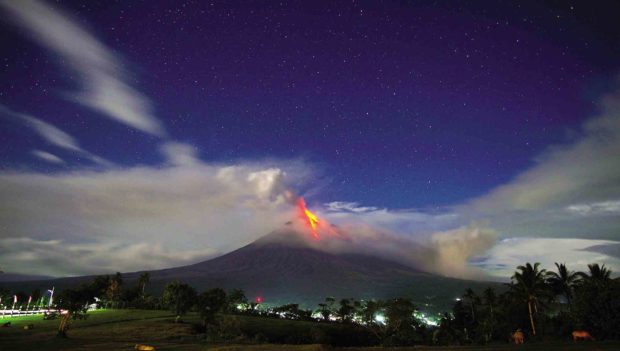Heavy rains trigger fears of mudflows around Mayon

TOURIST ATTRACTION Mayon’s eruption has drawn tourists to Camalig town in Albay. —MARK ALVIC ESPLANA
LEGAZPI CITY — Authorities on Saturday warned residents and local officials that millions of tons of ash and rocks could be dislodged by heavy rains and bury communities near Mt. Mayon in deadly mudflows.
The Philippine Institute of Volcanology and Seismology (Phivolcs) issued the warning to local government units (LGUs) and villages near river channels as rains lashed the surroundings of Mayon volcano, which had been emitting flaming lava and giant clouds of superheated ash for a week.
There were about 10.5 million cubic meters of volcanic ash and pyroclastic materials deposited in gullies since Mayon’s first eruption on Jan. 13, and rainwater could turn them into fast-moving mudflows, also called lahar, Phivolcs said.
Authorities estimated the volume of volcanic materials already expelled by Mayon to be the equivalent of about 10,000 Olympic-size (50 x 25 x 2 meters) swimming pools.
Potential lahars
Article continues after this advertisement“If there is ashfall and heavy rains, it can be converted into (a) lahar,” Phivolcs chief Renato Solidum told the French news agency Agence France-Presse (AFP).
Article continues after this advertisement“The important thing is to move out in case of heavy rains … this is a precautionary measure,” he added.
Potential lahars and “sediment-laden streamflows” could swamp river channels, especially in the villages of Miisi and Salvacion in Daraga town, Anoling and Quirangay in Camalig, Maninila and Masarawag in Guinobatan, Basud in Sto. Domingo, San Vicente and Buang in Tabaco City, and Buyoan and Mabinit in Legazpi City, according to Phivolcs.
The National Disaster Risk Reduction and Management Council (NDRRMC) on Saturday ordered LGU officials to move residents near rivers and other low-lying areas to higher ground.
It said heavy rains brought by the tail end of a cold front had increased the dangers of a “syn-eruption” (simultaneous with eruption) lahars in riverside communities.
“Communities and LGUs beside these river systems are advised to be additionally vigilant,” said NDRRMC Executive Director Ricardo Jalad.
Residents living on the banks of Yawa River in Barangay Cullat, Daraga town, expressed fears of a repeat of the August 2006 eruption. A typhoon four months later unleashed an avalanche of lahar that claimed some 1,000 lives.
“We are worried that lahar will flow again We cannot sleep soundly at night. We sleep like chickens, waking up at the slightest rumble of the volcano,” said Virginia Tuscano, 47, as rain poured outside her home.
“Back in 2006 the lahar flow was so powerful it was like waves sweeping away even homes made of cement,” the mother of three added.
Observers saw a shroud of steam covering the entire volcano as heavy rains met the hot lava and pyroclastic materials on its slopes.
Dwindling funds
Mayon volcano has remained under Alert Level 4 since Jan. 22, when it spewed out ash columns as high as 5 kilometers into the air, as well as lava fountains.
On Saturday, Paul Alanis, Phivolcs science and research scientist, said the volcano exhibited at least three sporadic lava fountaining that shot up ash plumes as high as 3 km and one pyroclastic flow, observed at the Missi gully.
A total of 79,586 persons from 20,675 families remained in evacuation centers in the cities of Legazpi, Tabaco and Ligao; and in the towns of Guinobatan, Camalig, Daraga, Sto. Domingo, Malilipot and Bacacay as of Saturday noon, according to Albay’s Provincial Disaster Risk Reduction and Management Office (PDRRMO).
Evacuees are housed in 24 schools, prompting Albay school authorities to cancel classes for some 21,500 students.
With disaster relief funds running low, Albay authorities late Friday recommended the realignment of P34.2 million in unspent funds of the provincial government from last year.
Relief operations
The new funds, P30 million of which is earmarked for relief operations, would be endorsed to the Sangguniang Panlalawigan for approval, said Cedric Daep, chief of Albay Public Safety and Emergency Management Office and executive officer of the PDRRMO.
Evacuation centers are already experiencing congestion, and the lack of toilets and potable water facilities are making the evacuees’ condition miserable, according to Fr. Rex Arjona, executive director of Social Action Center (SAC) under the Diocese of Legazpi.
He said evacuees were complaining of meager food rations and needed more face masks, hygiene kits, sleeping mats, mosquito nets and blankets.
The PDRRMO said it also needed to set up 667 more toilet facilities while the Department of Education had released funds for the construction of 112 temporary learning centers for young students in 76 evacuation centers.
The Office of Civil Defense said on Friday that it had already extended some P32.3 million in financial assistance to various Albay LGUs to help them deal with the calamity.
Help from religious groups
Arjona’s church-based group said they planned to distribute relief goods and hygiene kits to some 4,500 families in several evacuation centers.
The Church of Latter Day Saints, among SAC’s partners, delivered sleeping mats and hygiene kits to more than 1,000 families while 13 parishes under the Diocese of Legazpi set up daily soup kitchens and were offering church facilities to the most vulnerable evacuees, he said.
As of Saturday, provincial officials of the Department of Agriculture said the volcano’s continued activity had destroyed some P189.4 million worth of crops and livestocks.
Phivolcs said the 2,460-meter Mayon had emitted fountains of lava on Friday but bad weather was preventing observation of the volcano’s activity on Saturday.
The danger zone had been stretched as far as 9 km around Mayon—the most active of the country’s 22 volcanos and one of the deadliest—over fears of a possible deadly eruption.
Four foreign tourists and their local tour guide were killed when it erupted in May 2013.
In 1814, more than 1,200 people were killed when lava flows buried the nearby town of Cagsawa. —Reports from AFP, Mar S. Arguelles, Rey Anthony Ostria and Karl R. Ocampo